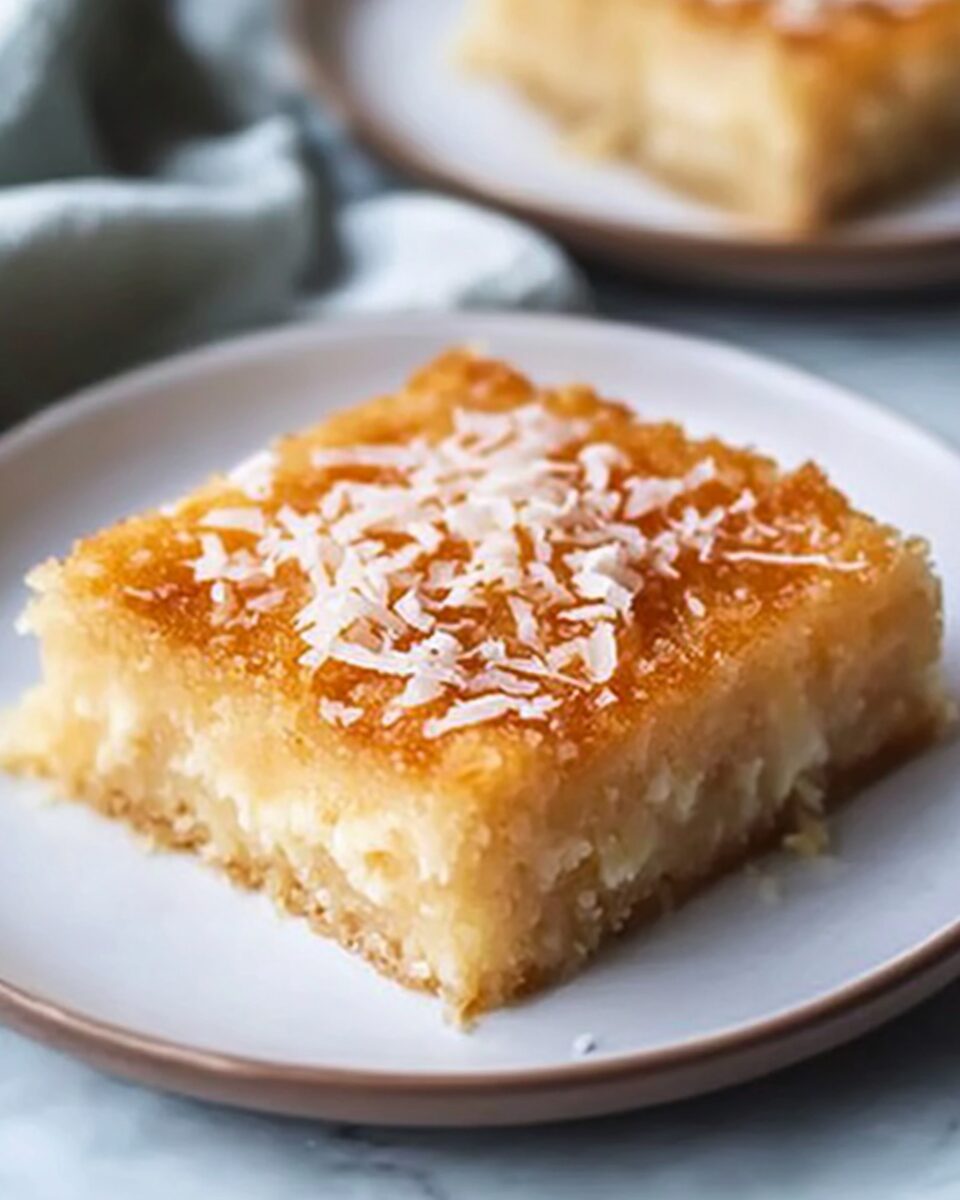Cassava cake is a rich and delicious Filipino dessert made from grated cassava, coconut milk, and a sweet custard-like topping. Its dense, moist texture and sweet flavor make it a popular choice for gatherings and special occasions.
FULL RECIPE
Ingredients
- 2 cups grated cassava (fresh or frozen)
- 1 cup coconut milk
- 1 cup condensed milk
- 1/2 cup evaporated milk
- 2 large eggs
- 1/2 cup sugar
- 1/4 cup butter, melted
- 1 teaspoon vanilla extract
- 1/4 cup grated coconut (optional for topping)
Directions
- Preheat the oven to 350°F (175°C) and grease a baking pan.
- In a large bowl, combine grated cassava, coconut milk, condensed milk, evaporated milk, eggs, sugar, melted butter, and vanilla extract. Mix until smooth.
- Pour the mixture into the prepared baking pan and spread it evenly.
- Bake for 45-60 minutes or until the top is golden brown and the cake is set.
- If using, sprinkle grated coconut on top of the cake during the last 10 minutes of baking for added texture and flavor.
- Allow the cake to cool before slicing and serving.
Nutritional Information
- Calories: 300 per serving
- Carbohydrates: 45g
- Protein: 3g
- Fat: 12g
- Fiber: 2g
- Sugar: 25g
History of Cassava Cake
Cassava cake holds a special place in Filipino culinary heritage. Originating from the cassava root, which was introduced to the Philippines by the Spanish during the colonial era, this dessert has been embraced by Filipino families for generations. Initially, cassava was used for more practical purposes, but over time, its versatility led to its inclusion in desserts. The Filipino version of cassava cake is distinguished by its unique texture, derived from grated cassava, and its indulgent, creamy flavor. This dessert has evolved over the years, with countless regional variations adding their own twist to the original recipe. Today, cassava cake is a common feature in Filipino feasts, especially during holidays and special family gatherings.
Cultural Significance of Cassava Cake
In Filipino culture, food is much more than just nourishment—it is a symbol of love, hospitality, and togetherness. Cassava cake, in particular, is not only a dessert but also an emblem of celebration. Whether at a birthday, wedding, Christmas, or any festive occasion, cassava cake is often the centerpiece, bringing people together around the table. The act of sharing this dessert reflects Filipino values of family and community. It is also common for cassava cake to be passed around at gatherings, a gesture that signifies warmth and generosity, making it a much-loved treat across generations.
What Makes Cassava Cake Unique?
What makes cassava cake so distinctive is its texture and flavor. Unlike traditional cakes, which are made from flour, cassava cake is made with grated cassava, which results in a dense, pudding-like consistency. The combination of coconut milk, sweetened condensed milk, and butter gives the cake its richness, while the subtle sweetness of cassava complements the creaminess of these ingredients. This dessert is not overly sugary, but its depth of flavor, along with its smooth and chewy texture, makes it irresistibly satisfying. It’s a dessert that is both comforting and indulgent.
Varieties of Cassava Cake
While the basic cassava cake recipe is consistent, there are many regional variations across the Philippines. In some areas, cheese is added, providing a savory contrast to the sweetness of the cake. Other versions include a custard-like topping, which adds a smooth, creamy layer to the cake. Some versions even incorporate other root vegetables, such as sweet potatoes or yams, adding different textures and flavors to the dish. These regional differences reflect the creativity of Filipino home cooks and their ability to adapt traditional recipes to suit local tastes. Whether simple or elaborate, each version of cassava cake remains a beloved part of Filipino culinary tradition.
The Importance of Cassava in Filipino Cuisine
Cassava, or “kamoteng kahoy,” is one of the Philippines’ most important agricultural products. It is used in a variety of dishes, both sweet and savory. Aside from cassava cake, this versatile root is featured in snacks like cassava chips, puddings, and savory side dishes like “nilupak,” a mashed cassava dish often served with meats. Cassava’s widespread use in Filipino cuisine reflects its availability and nutritional value. It’s a reliable ingredient that supports many types of dishes, from comforting desserts to hearty meals. Its presence in Filipino kitchens is undeniable, and its use in cassava cake highlights its importance in the culinary landscape.
Health Benefits of Cassava
While cassava cake is a rich dessert, the cassava root itself offers various health benefits. Rich in carbohydrates, cassava provides a significant source of energy, making it particularly valuable in tropical countries. It is also a good source of dietary fiber, which helps promote digestion and prevent constipation. Additionally, cassava contains vitamins and minerals like vitamin C, thiamine, and folate, all of which are essential for immune health and overall well-being. Although cassava cake is a treat, the nutritional benefits of cassava make it a more wholesome choice compared to other, more refined sugary desserts.
How to Choose the Best Cassava for Cassava Cake
Choosing the right cassava is crucial for making a successful cassava cake. Fresh cassava should be firm, with smooth skin and no soft spots. If you’re using frozen cassava, ensure it is fully thawed and well-drained before use to prevent excess moisture from ruining the cake’s texture. Grated cassava, if used, should be thoroughly squeezed to remove as much liquid as possible. This step is important for achieving the right consistency in the finished cake. Whether fresh or frozen, the quality of the cassava you use will directly affect the outcome of your cassava cake.
The Role of Coconut Milk in Cassava Cake
Coconut milk is an essential ingredient that gives cassava cake its signature creamy texture and rich flavor. It enhances the sweetness of the cassava while adding a smooth, velvety consistency. Coconut milk also contributes to the cake’s tropical appeal, making it feel like a true Filipino treat. This ingredient not only deepens the flavor of the cake but also adds to its luxurious mouthfeel, setting cassava cake apart from other desserts. Coconut milk is a key feature of many Filipino dishes, both savory and sweet, and its use in cassava cake highlights the importance of coconut in Filipino cooking.
Making Cassava Cake Ahead of Time
Cassava cake is an excellent dessert to prepare ahead of time. In fact, it often tastes better the day after it is made, as the flavors have had more time to meld together. To make it in advance, simply bake the cake, allow it to cool completely, and store it in an airtight container in the refrigerator. The cake will stay fresh for several days, and you can enjoy it either cold or reheated. Making cassava cake ahead of time also allows you to free up time on the day of an event, making it a great option for busy celebrations.
Serving Suggestions for Cassava Cake
Cassava cake can be enjoyed in a variety of ways, depending on your preference. It is commonly served on its own as a satisfying dessert, but it also pairs wonderfully with fresh fruit or a hot beverage like coffee or tea. Some people also enjoy it with a scoop of vanilla ice cream or a dollop of whipped cream, which adds an extra indulgent touch. No matter how you choose to serve it, cassava cake is a dessert that can easily be dressed up or served simply, making it versatile enough for any occasion.
Cassava Cake for Special Occasions
Cassava cake is a popular choice for special occasions in Filipino culture. It is often prepared for birthdays, weddings, holidays, and other significant events. Its rich flavor and comforting texture make it a standout dessert at any gathering. In Filipino households, cassava cake is often shared with family and friends as a gesture of hospitality. It is also commonly featured alongside other Filipino dishes such as lechon, pancit, and lumpia, making it a central part of festive meals. No matter the occasion, cassava cake’s presence is always sure to be appreciated by guests.
Tips for Perfecting Cassava Cake
To ensure your cassava cake turns out perfectly, follow a few key tips. First, make sure the cassava is properly drained to remove excess moisture. This will help prevent the cake from becoming soggy. Second, be careful not to overmix the ingredients, as this can affect the texture. Lastly, bake the cake at the right temperature and monitor it carefully to avoid overbaking. Test for doneness by inserting a toothpick in the center—if it comes out clean, the cake is ready. Allow the cake to cool before slicing, as this will help achieve clean cuts and allow the flavors to develop.
The Role of Eggs in Cassava Cake
Eggs are an important ingredient in cassava cake, contributing to its structure and texture. They help bind the ingredients together and give the cake a slightly fluffy texture, balancing its otherwise dense consistency. Eggs also add richness to the cake, enhancing the overall flavor. Be sure to use fresh eggs, as they will blend more easily into the batter and help create a smooth, consistent texture throughout the cake. The eggs, along with the other ingredients, work together to create a cake that is both dense and moist, with a pleasing mouthfeel.
Cassava Cake for Dietary Restrictions
While traditional cassava cake contains dairy and gluten, it can easily be modified to accommodate dietary restrictions. For those following a gluten-free diet, substitute the regular flour with a gluten-free flour blend or rice flour. To make the cake dairy-free, replace the butter and milk with plant-based alternatives, such as coconut oil and almond milk. These substitutions allow those with dietary restrictions to enjoy the rich, comforting flavors of cassava cake without compromising their dietary needs. With a few adjustments, cassava cake can be enjoyed by nearly everyone.
Cassava Cake and Sustainability
Cassava is an environmentally friendly ingredient, making it a sustainable choice for many Filipino desserts. It is a drought-resistant crop that requires minimal water and grows well in a variety of soil conditions. This makes it an ideal crop for regions where other crops may struggle. By using locally grown cassava, we reduce the need to import ingredients, thereby lowering our carbon footprint. Choosing sustainable ingredients like cassava for dishes such as cassava cake not only supports local farmers but also helps protect the environment.
Popular Variations of Cassava Cake
There are many variations of cassava cake across the Philippines, each with its own regional twist. Some versions use cheese, creating a savory-sweet balance that enhances the cake’s flavor. Others include a custard topping, giving the cake a smooth, silky finish. These regional differences reflect the diversity of Filipino cooking and the creative ways in which home cooks adapt recipes to suit local tastes. No matter the variation, cassava cake remains a beloved dessert that showcases the creativity and resourcefulness of Filipino cuisine.
Cassava Cake: A Dessert for All Ages
Cassava cake is a dessert that appeals to people of all ages. Its sweet, dense texture is enjoyed by children, while its rich flavor and satisfying consistency make it a favorite among adults as well. The cake’s simplicity and indulgence make it perfect for both casual snacks and special occasions. Its universal appeal ensures that it will continue to be a dessert enjoyed by generations to come, making it a true Filipino classic.
Conclusion
Cassava cake is a Filipino dessert that has stood the test of time, with its rich flavor, unique texture, and cultural significance. Whether enjoyed at a family gathering, holiday celebration, or simply as a treat for yourself, cassava cake brings comfort and joy. Its versatility and ability to be adapted to suit various tastes make it a dessert that will continue to thrive in Filipino kitchens. With its deep roots in Filipino culture and cuisine, cassava cake remains a cherished tradition that embodies the warmth and hospitality of the Philippines.






